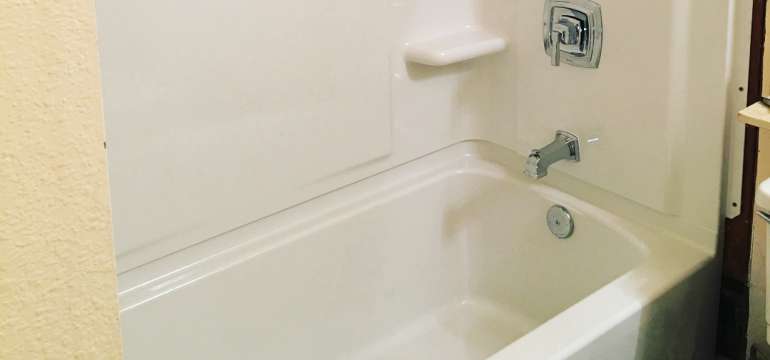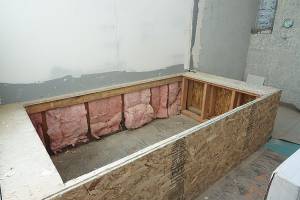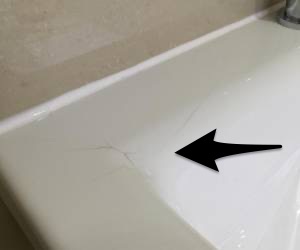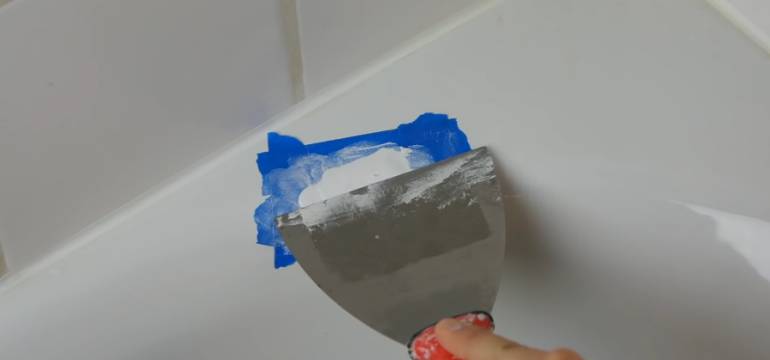Are you jumping into a bathroom renovation? Installing a brand new bathroom in a new home? Either way, you’ll need to become familiar with the different available materials for bathtubs and the advantages they have over each other. In this guide, we’ll focus on Vikrell material; a composite often used to create tubs or tub and shower combo units.
Explore the definition of poly composite bathtubs, find out what Vikrell is, and explore the differences between Vikrell and a couple of other common bathtub materials. With all this information under your belt, you’re sure to be better prepared for selecting the right bathtub unit for your home.
What Are Poly Composite Bathtubs?

Poly composite bathtubs are made with an engineered composite substance. The exact formula of the substance depends on the manufacturer; each type of poly composite used for bathtubs is proprietary, which means the formula belongs to the company producing it and contains specific ingredients to help it achieve the desired durability and other features.
Composite tub materials create the backing or core of the tub, but the surface is actually covered with enamel.
Most poly composite bathtubs include some variation of the following ingredients: crushed limestone and resin, fiberglass, acrylic, granite with resin, or other poly plastic fibers.
What Is Vikrell?

Vikrell is one brand of many in the realm of poly composite bathtubs and other home fixtures. With Vikrell, the underlying material of the tub consists of fiberglass and polyresin.
Basically, it is comprised of very thin fibers of glass, along with plastic. When that fiberglass substance is blended with polyresin, the entire composite becomes much stronger and more durable while still retaining malleability during the process of forming and manufacturing the tub itself.
Benefits of Vikrell Bathtubs
Bathtubs made of Vikrell poly composite are more lightweight than those made of cast iron or some other popular bathtub materials. Since they are not as heavy, they are easier to mobilize and install within the bathroom of a new home. Plus, they are fairly tough products. A Vikrell bathtub can last with no issues for many years.
In fact, Vikrell offers a 10-year residential warranty on its products, including bathtubs, and it ensures a commercial warranty of three years for its products.
Since the poly composite substance called Vikrell is so moldable during the manufacturing process, it can be formed into just the right pieces.
 These pieces fit together perfectly and tightly to create a bath and shower combo or just a bathtub, and because of the tight fit, the entire assembly can remain watertight without you needing to caulk any seams. Thanks to these interlocking sections, a watertight seal is achieved without much effort on your part, which is great news if you’re installing a new bathroom or renovating an old one.
These pieces fit together perfectly and tightly to create a bath and shower combo or just a bathtub, and because of the tight fit, the entire assembly can remain watertight without you needing to caulk any seams. Thanks to these interlocking sections, a watertight seal is achieved without much effort on your part, which is great news if you’re installing a new bathroom or renovating an old one.
The process is time-consuming enough, and you definitely don’t need another thing to caulk, so poly composite bathtubs made of Vikrell material are definitely a plus from that point of view.
Another great benefit of Vikrell material is its resistance to stains. Your bathtub is going to endure a lot of wear and tear, and it might be exposed to a broad range of dirt and other substances that might stain.
While certain chemicals could discolor the tub, your Vikrell material bathtub will likely retain its original color very well over time. Most dirt and other unwanted substances will wash right off, or can easily be removed with the application of a bit of tub cleaner or bleach. That’s good news for homeowners who want to keep their bathroom looking pristine.
Drawbacks of Vikrell Material for Bathtubs
As with any product, there are also a few drawbacks to the use of Vikrell material for bathtubs. Usually, problems occur when the users installing the tub don’t follow the correct installation procedures. While these pieces are not difficult to install, they do require some understanding of the correct foundation and placement.
 When you install a poly composite bathtub such as a Vikrell bathtub, you need to have a mound or layer of cement or mortar beneath it. Yes, you need a mortar bed or a similar foundation, even if the manufacturer says you don’t. The foundation supports the bathtub, preventing it from warping, popping, flexing, or breaking.
When you install a poly composite bathtub such as a Vikrell bathtub, you need to have a mound or layer of cement or mortar beneath it. Yes, you need a mortar bed or a similar foundation, even if the manufacturer says you don’t. The foundation supports the bathtub, preventing it from warping, popping, flexing, or breaking.
The mortar bed is the tough, durable base of the poly composite tub, a sturdy underlying foundation. Without the right cement or mortar base, the tub is more liable to crack or break. After all, its core material is at least partly made from fiberglass, which, as the name implies, contains glass fibers. While fiberglass is strong, it’s still glass-adjacent, which means it can be brittle given certain types of impact.
Let’s say you didn’t install the right cement support underneath a Vikrell tub. At this point, anything can crack the material, even dropping a full bottle of conditioner or a hard bar of soap from an adult’s height.
That’s why it’s key to give your tub all the support it needs by way of a foundation. If you’re not sure how to do this, explore the full process online by way of instructional videos on YouTube.
Let’s look at one more slight disadvantage. Vikrell and other makers of poly composite tubs advertise that their products don’t need to be caulked. However, depending on the type of tub you buy, your level of use, and your full shower setup, you may find that certain seams need to be closed off or caulked to prevent mold and mildew from building up deep inside. If the bathtub isn’t a perfect fit for the space in your bathroom, that fact may also make caulking necessary.
Does Vikrell Crack?
As previously mentioned, Vikrell can indeed crack with the right amount of force or a specific type of impact. Vikrell and other poly composite tub materials can also crack due to repetitive stress over time.
What kind of stress cracks might you expect? Well, let’s imagine that you installed a shower and tub combo unit of Vikrell material or a similar material. You might have a molded shelf or two in the shower, where users can set bottles of shampoo or other necessary items.
 After years of sustaining heavy bottles, the shelf may develop a hairline crack either underneath or at one of its corners, especially if users are setting the bottles down hard on the shelf after each use.
After years of sustaining heavy bottles, the shelf may develop a hairline crack either underneath or at one of its corners, especially if users are setting the bottles down hard on the shelf after each use.
Vikrell can crack if you drop something hard and heavy. Sometimes a full bottle of shampoo might do it, although this is less likely if the tub is properly supported. It’s more likely to happen if, for example, you were mounting a light over the shower and dropped your power drill or a screwdriver.
Cracks can also occur during the installation process. That’s why it’s important to enlist the help of friends when you’re moving your new Vikrell tub or shower unit into place. Make sure that your friends understand the importance of being careful with the unit, not crashing it into corners, setting it down too hard, or exerting too much torsion-type pressure on its edges.
Can I Repair a Vikrell Material Crack?

If a crack does occur in your Vikrell tub, your first step is to consult your manufacturer’s warranty. If the unit is still under warranty, the company will probably give you a new one for free. If it’s not, you’ll need to choose between patching the crack and replacing the unit.
If the crack is small and minimal, just a hairline fracture, you may be able to get away with simply caulking over it. Use clear silicone caulk that is waterproof to seal thoroughly over the crack, making sure you cover every bit of it. Obviously, if the stress that caused the crack continues, it will likely get worse over time and expand beyond the bead of caulk you laid down.
If the crack is broader or deeper than a hairline, but still not too bad, you can obtain a repair kit to fix it. The manufacturer may sell these, or you may be able to obtain a generic one either online or in local hardware or home improvement store.
The putty or repair substance in the kit will fill the crack, and then you’ll touch up the area in a color that closely matches your tub and seal over it with caulk for waterproofing purposes.
Of course, if the crack has spiderwebbed, or if there are major chips missing from the tub’s surface, or if the crack is very deep, you will need to think about replacing the entire unit. Unless it is under warranty, this can be costly.
However, the cost of leaving a cracked tub in place and continuing to use it may be even higher in the long run. If you keep using a cracked tub or tub and shower combo, water will start seeping through that crack, leaking into your floor or wall.
Eventually, mold can grow, wood can rot, and the structure of that section of your home may become weaker. It’s very important to deal with potential water damage immediately because it can seriously affect the health of your home, and it can cost a lot of money to fix that damage. So think ahead and replace a damaged tub before it leaks and costs you far more than the price of a replacement unit.
Vikrell vs. Acrylic
If you’re still debating which tub material to use, you’re likely going to want to know the differences between Vikrell vs. acrylic. While the end products of these two options may look similar, they’re actually quite different.
Composition and Design
Vikrell, as we know, combines fiberglass, resin, and a number of fillers. It’s a patented material from Kohler, and decently popular among users. Vikrell tubs look good, are aesthetically pleasing, and offer durable long-term use. A Vikrell surface lacks pores of any kind, which makes it ultra waterproof and also enables easy cleaning and stain resistance.
Acrylic also incorporates fiberglass at its core. However, the fiberglass sheets used to form acrylic tubs are implemented differently. Instead of being part of a more complex substance that includes resin and fillers, this fiberglass is in sheets, and it’s used to form the core of the tub.
Over the base layers of fiberglass, manufacturers include layers of colored, opaque acrylic. Since acrylic is also quite durable, many users like it. They also appreciate its aesthetic value, since it’s got the shiny, glossy look homeowners want. You can also obtain acrylic tubs in a variety of different colors—more variety than you’ll find with Vikrell tubs. Acrylic tubs, showers, and sinks are often installed in higher-end bathrooms.
Durability
Vikrell tends to break a little more easily than acrylic does. It’s a bit more susceptible to cracks and chips, because of the nature of the material and its composition. Acrylic is really hard to crack or break, although it can sometimes happen.
However, in the day to day use of regular tubs and showers, Vikrell is more likely to develops chips or cracks than an acrylic tub would be.
However, when it comes to chemicals and stain resistance, Vikrell gains back a little of the high ground. Acrylic reacts with chemicals much more readily than Vikrell does.
In fact, even certain soaps, shampoos, hair dyes, bath bombs, or other products can cause an acrylic tub or shower to develop discoloration or staining. On the other hand, Vikrell is extremely resistant to staining or similar chemical reactions.
Vikrell vs. Americast
Americast tubs are made with molded backing of poly composite, proprietary to the manufacturer, American Standard. Over the composite core or backing, Americast includes a layer of enameling grade steel, to ensure extra durability and resistance to cracks, flexing, and breakage. Over the metal layer is the porcelain enamel finish.
The finish of an Americast tub isn’t super durable and may crack given enough impact, but thanks to the enameling grade steel layer beneath, the crack is unlikely to go too deep and cause the tub to become unusable.
You’ll just need to caulk or patch the crack to ensure that no water gets in. The structural integrity of Americast tubs are sometimes considered superior to Vikrell units. Plus, Americast advertises its products as having greater heat retention than some other types of tubs, meaning that your bathwater will stay warmer longer.
Vikrell has a price advantage here. It’s less expensive than most Americast tubs, which makes it appealing for homeowners going through an expensive bathroom installation or renovation. It’s also a bit lighter, which makes it easier to install, and that can be a huge benefit if you’re going the DIY route with your bathroom reno.
Ultimately, Vikrell and Americast are fairly comparable products. Both are likely to crack under severe impact, though Americast maybe a little less likely to crack from repetitive stress. An Americast tub also less likely to flex, thanks to its metal layer.
However, if your budget doesn’t allow for the extra expense of Americast, or if you prefer a more lightweight unit, Vikrell’s Sterling products have excellent reviews and should serve you well.
Cast Iron Tubs

Maybe you’ve been considering the possibility of a cast iron tub as well. While these tubs are wonderful and durable, they are far more expensive than poly composite options like Vikrell.
They are also much, much heavier, so heavy that you’ll need to include extra framing beneath your bathroom if you want to install one. These tubs are also known to be extra slippery, and they transfer a lot of noise.
They also don’t hold in heat as well, so those nice relaxing hot baths will quickly turn tepid or cool as warmth leaches out of the water through the cast iron sides of the tub. If you’re looking for an inexpensive, lighter weight, more comfortable option, you probably want to skip cast iron and go straight for the composite options.
As you choose between Vikrell vs. acrylic, or Vikrell vs. Americast, it’s important to consider how you plan to use your tub or shower, and how each product would fit into your way of life.
If you plan to use a variety of bath products that may or may not stain, Vikrell is your best choice. If you need a shower or tub that can withstand extra force and impact, perhaps acrylic might work better for you. Take your time investigating each product and considering which one will fit smoothly into your bathroom design and your lifestyle.
- How to Cut Lexan - September 25, 2020
- Mineral Spirits vs. Mineral Oil - September 25, 2020
- Shellac vs. Polyurethane - September 24, 2020
